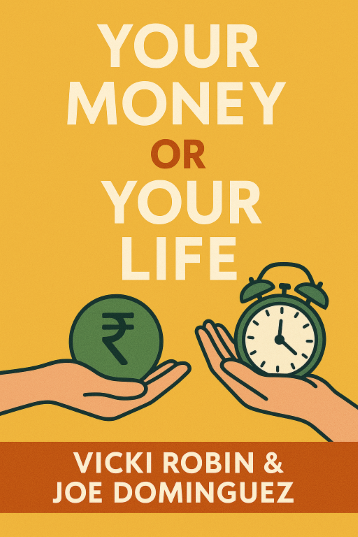INTRODUCTION: “IS THIS WORTH MY LIFE?”
Let’s be honest — you didn’t just spend Rs.300 on a pizza. You traded 30 minutes of your life for it (or maybe more, depending on your job).
Sounds dramatic? That’s exactly what Your Money or Your Life wants you to realise.
This isn’t your average money book about cutting lattes and making Excel sheets scream in terror. It’s about conscious living, financial independence, and understanding that money is just life energy in disguise.
So if you’re ready to stop mindless spending, quit living paycheck-to-paycheck, and finally get your finances to align with your actual life, grab your metaphorical highlighter — this one’s going to hit deep.
Let’s dive further into your money or your life summary.
🧠 BIG IDEA: MONEY = LIFE ENERGY
The first revolutionary idea this book throws at you is simple but profound:
You trade your time and energy for money.
So every rupee you spend is a little chunk of your life gone. Poof.
So the big question becomes:
Are you getting a good return on that time and energy?
If you’re working overtime to pay for things you don’t even care about… something’s gotta give.
📈 STEP 1: CALCULATE YOUR REAL HOURLY WAGE
You might think you make Rs 800/hour, but hold up, what about:
- Commute time
- Work clothes
- De-stress splurges
- That one coworker who drains your soul?
When you factor in all that, your real hourly wage might be closer to Rs 500/hour, or less.
Now ask yourself:
Was that Rs 2000 dinner worth 3 hours of my life?
Game. Changed.
💸 STEP 2: TRACK EVERY RUPEE (WITH ZERO JUDGMENT)
Yep, every. single. rupee.
For 1–2 months, track every expense with a simple log. But this isn’t about being frugal or guilty — it’s about awareness.
This tracking habit helps you see where your money is going, versus where you think it is.
Spoiler: it’s often depressing, but also empowering.
🧾 STEP 3: CATEGORIZE SPENDING BASED ON LIFE VALUE
For every expense, ask three brutally honest questions:
- Did I find fulfilment proportional to the life energy I invested?
- Is this aligned with my values and purpose?
- Would I choose to do this again, knowing what I now know?
You’ll start spotting money leaks faster than Netflix auto-renews.
💡 STEP 4: CREATE A WALL CHART (YES, REALLY)
Draw a monthly graph of your income and expenses. The visual part helps keep you accountable and — let’s face it — guilt-tripped in a good way.
You’ll see how small improvements compound, and when your expenses dip below your income consistently… that’s where the magic begins.
🔄 STEP 5: DECLUTTER YOUR LIFESTYLE
Start trimming what doesn’t bring you joy, not out of deprivation, but because your life energy deserves better.
This might mean:
- Cancelling unused subscriptions
- Eating out less
- Letting go of “status purchases”
- Saying “no” to impulse buys (no more cart full of stuff you didn’t need)
It’s minimalist finance. Not “poor,” just intentional.
🔁 STEP 6: REWIRE YOUR MONEY MINDSET
This isn’t just a finance book. It’s a mindset reset. The goal?
Stop working for money. Start making money work for you.
That means:
- Finding your “enough” point
- Avoiding lifestyle inflation
- Prioritising time over stuff
- Pursuing meaning, not just more
🧘♂️ STEP 7: REACH FI (FINANCIAL INDEPENDENCE)
Once you reduce expenses, increase savings, and invest wisely, you build what’s called a “crossover point.”
That’s the day your investment income covers your monthly expenses.
After that?
You’re free. You work if you want to, not because you have to.
No, you don’t need millions. You need less overhead and more clarity. FI is possible — without being a millionaire.
⚠️ DON’T MISS THE SPIRITUAL SIDE
This isn’t all calculators and charts. The heart of the book is about living with purpose, not just budgeting better.
“Money is something we choose to trade our life energy for.”
Once you see money as sacred, you’ll stop wasting it on cheap dopamine and start investing it in what matters.
9-Step Program (Quick Overview)
| Step | What You Do |
|---|---|
| 1 | Make peace with your past finances |
| 2 | Track every rupee you spend |
| 3 | Ask: Was this spending worth my life energy? |
| 4 | Create a monthly wall chart |
| 5 | Reduce spending & declutter your life |
| 6 | Respect your life energy |
| 7 | Get out of the 9–5 trap |
| 8 | Build investment income |
| 9 | Reach FI and live on your terms |
🧠 FINAL THOUGHTS: IS YOUR LIFE ENERGY WELL SPENT?
Your Money or Your Life isn’t just a book. It’s a lifestyle intervention. It shakes your assumptions, rewires your habits, and asks you to take back control — not just of your wallet, but your whole life.
You don’t need more money. You need more clarity, intention, and freedom.
And if you stick with the principles in this book?
That freedom is closer than you think.
